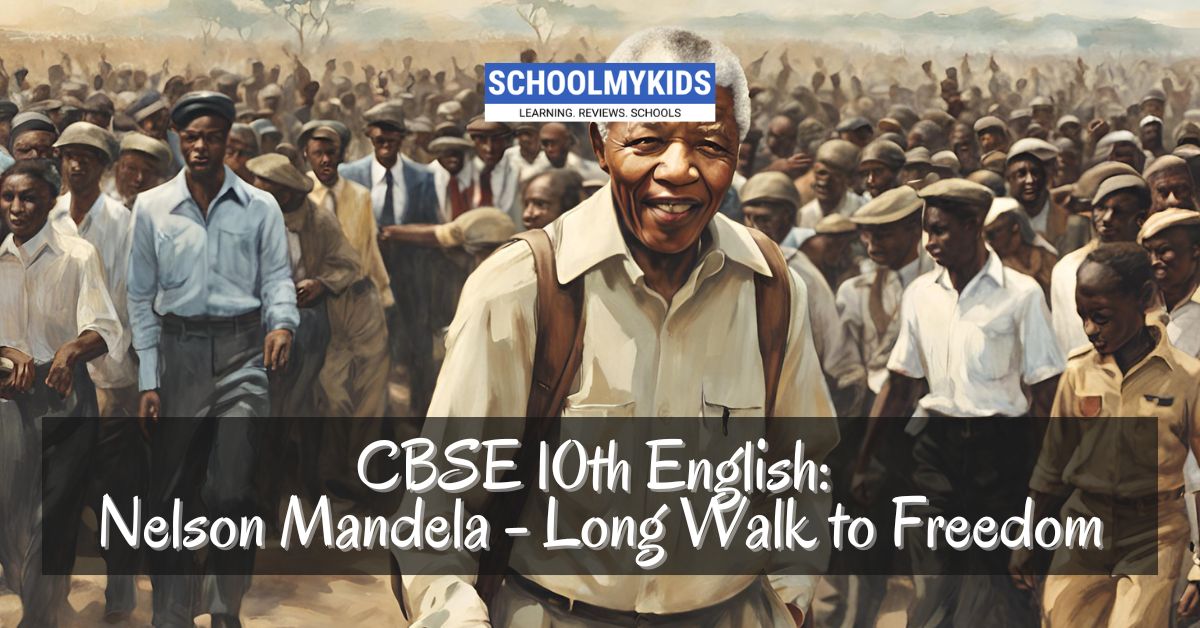Unveiling the Fight for Freedom in South Africa
Nelson Mandela’s autobiography, “Long Walk to Freedom,” is a powerful and inspiring read, especially for students within the CBSE English curriculum. This summary delves into the key themes and historical context relevant to your studies.
A Journey Towards Equality
The book chronicles Mandela’s life, specifically his unwavering fight against the oppressive system of apartheid in South Africa. Apartheid enforced racial segregation, denying basic rights to the black majority. Mandela’s story serves as a beacon of hope, showcasing the human spirit’s ability to overcome injustice and pave the way for a more equitable future.
From Personal Freedom to Collective Liberation
The narrative explores how Mandela’s understanding of freedom evolved. Initially, it encompassed basic freedoms like choosing his path and staying out late. As he matured, he recognized the significance of fundamental human rights and the fight against racial discrimination.
The Struggle Against Apartheid: A Defining Chapter
A central theme revolves around the fight against apartheid. The book details Mandela’s experiences as a political activist, his imprisonment on Robben Island for 27 years, and his unwavering commitment to dismantling the system. It sheds light on the sacrifices made by countless individuals in the pursuit of freedom.
Leading by Example: Reconciliation and Forgiveness
Upon his release in 1990, Mandela became a pivotal figure in dismantling apartheid and leading South Africa towards a multiracial democracy. The book emphasizes his dedication to reconciliation and forgiveness, even towards those who wronged him. Mandela’s leadership serves as a powerful model for promoting equality and justice around the globe.
Aligning with CBSE Values
“Long Walk to Freedom” aligns perfectly with the values emphasized by CBSE English. It provides a historical perspective on the fight against apartheid and the importance of human rights. Furthermore, Mandela’s story offers a compelling example of resilience, leadership, and the power of forgiveness.
Beyond the Political Landscape
While the book delves into the political arena, it also offers insights into Mandela’s personal life. Readers gain a glimpse into his relationships with family and friends, along with his thoughts and emotions during his imprisonment.
Exploring Language and Literary Devices
Analyzing the use of language and literary devices within the book can further enhance your understanding of how Mandela presents his experiences and conveys his message.
A Must-Read for CBSE Students
“Long Walk to Freedom” is a significant read for CBSE students. It offers valuable lessons about history, social justice, and the unwavering pursuit of one’s beliefs.
20 Questions and Answers on Nelson Mandela’s “Long Walk to Freedom” (CBSE English Focus)
Early Life and Understanding of Freedom (Q1-Q5):
- Where and when was Nelson Mandela born?
- Answer: Nelson Mandela was born in Mvezo, South Africa, in 1918.
- What were some of the limitations Mandela faced as a young boy?
- Answer: As a young boy, Mandela craved basic freedoms like staying out late and choosing his path, which were restricted by traditional customs.
- How did Mandela’s understanding of freedom evolve as he grew up?
- Answer: As he matured, Mandela realized the importance of fundamental human rights and the fight against racial segregation.
- What was Mandela’s tribal name and its significance?
- Answer: Mandela’s tribal name was Rolihlahla, meaning “troublemaker” or “stirrer.” This foreshadowed his future role as an activist.
- What education did Mandela pursue, and how did it influence him?
- Answer: Mandela pursued a law degree, which equipped him with the knowledge and skills to fight for justice within the legal system.
The Struggle Against Apartheid (Q6-Q10):
- What was apartheid, and how did it impact South Africa?
- Answer: Apartheid was a system of racial discrimination that denied basic rights to the black majority in South Africa.
- What political party did Mandela join, and why?
- Answer: Mandela joined the African National Congress (ANC) to fight against apartheid and advocate for racial equality.
- What were some of the non-violent resistance tactics employed by the ANC?
- Answer: The ANC used peaceful protests, boycotts, and strikes to dismantle apartheid.
- Why was Mandela arrested and imprisoned in 1962?
- Answer: Mandela was arrested for sabotage and conspiracy to overthrow the government due to his role in the ANC.
- What were the living conditions like for Mandela on Robben Island?
- Answer: Robben Island prison was harsh, with forced labor and limited contact with the outside world.
Leadership and Legacy (Q11-Q15):
- How did Mandela maintain his spirit and leadership during his imprisonment?
- Answer: Mandela used his time in prison to study, exercise, and maintain his mental strength, inspiring fellow prisoners.
- What role did Mandela play in the negotiations to end apartheid?
- Answer: After his release in 1990, Mandela became a key figure in dismantling apartheid through peaceful negotiations.
- Why was Mandela’s commitment to reconciliation and forgiveness so significant?
- Answer: Mandela’s approach fostered healing and unity between previously divided racial groups in South Africa.
- What position did Mandela hold after the end of apartheid?
- Answer: Mandela became the first black president of South Africa in 1994, leading the country towards a multiracial democracy.
- What are some of Mandela’s lasting legacies beyond South Africa?
- Answer: Mandela’s legacy extends globally, inspiring movements for freedom, justice, and reconciliation.
Themes and Analysis (Q16-Q20):
- Identify some of the central themes explored in “Long Walk to Freedom.”
- Answer: The themes include the fight for justice, overcoming adversity, the importance of freedom, the power of forgiveness, and the pursuit of equality.
- How does the book portray the psychological impact of imprisonment?
- Answer: The book reveals the mental struggles and resilience required to endure long-term imprisonment.
- What literary devices does Mandela use to convey his message effectively?
- Answer: Mandela might use techniques like personal anecdotes, historical context, and descriptions of his emotions to engage the reader.
- Why is “Long Walk to Freedom” considered a valuable resource for CBSE students?
- Answer: The book provides a historical perspective on the fight against apartheid and promotes values like courage, perseverance, and the importance of fighting for what one believes in.
- How can analyzing “Long Walk to Freedom” benefit your understanding of social justice issues?
- Answer: Studying the book fosters critical thinking about social inequalities and the importance of advocating for fair treatment for all.









Be the first one to comment on this story.